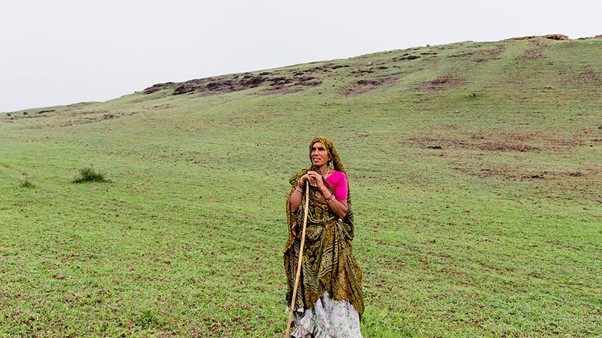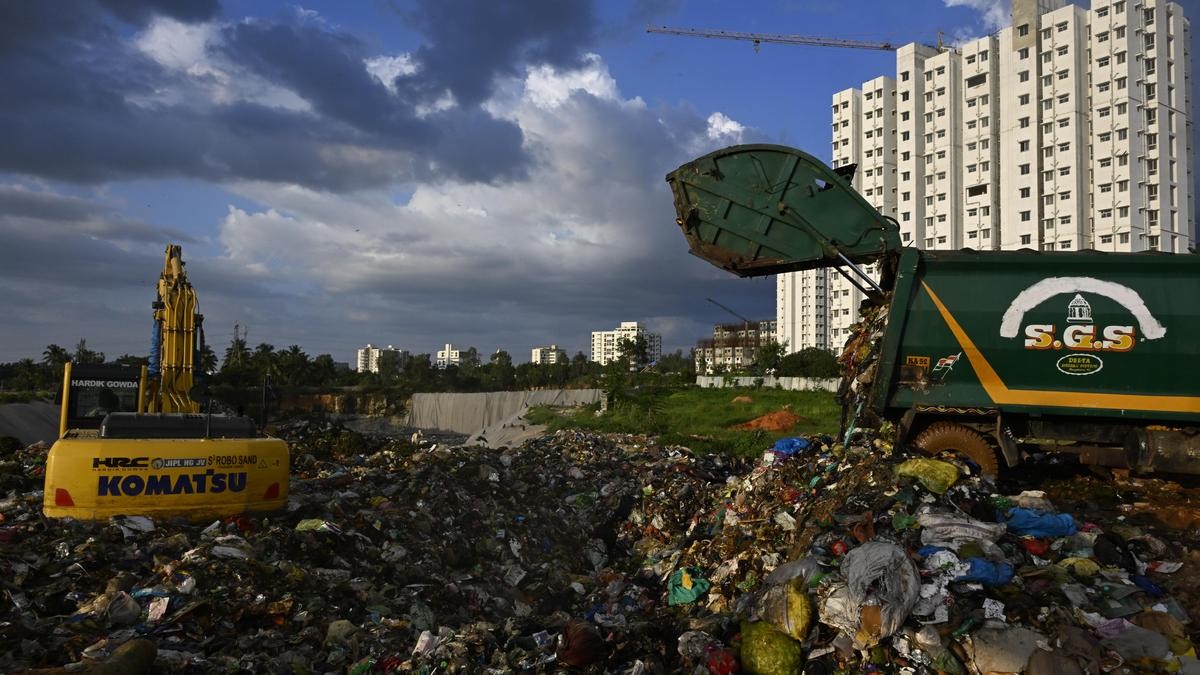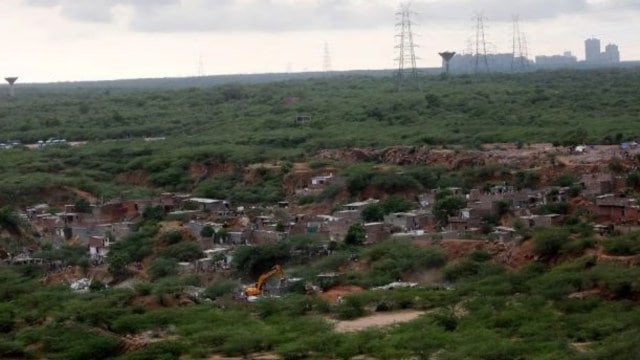Copyright infringement not intended
Picture Courtesy:The Hindu
Context:
The Himalayas have witnessed a sharp rise in natural disasters such as glacial lake outbursts, landslides, floods, wildfires, and earthquakes. According to a 2024 Down To Earth report, out of 687 disasters recorded in India between 1900 and 2022, nearly 240 occurred in the Himalayan region.
Current Status:
- A parliamentary committee (March 2023) noted a “severe shortage” of meteorological and monitoring stations in the Indian Himalayan Region, and that most existing systems were designed for single hazards rather than cascading/multi-hazard events.
- The central government has initiated the setup of Early Warning System (EWS) for Glacier Lake Outburst Floods (GLOF): 188 “critical” glacial lakes have been identified for EWS deployment.
- The Central Water Commission (CWC) reported that in June 2025 out of 2,843 glacial lakes & water bodies in the Himalayan region under monitoring, 1,435 showed an increase in area.
- The Geological Survey of India’s National Landslide Forecasting Centre (NLFC) is expanding landslide EWS coverage and aims for nationwide reach by 2030, including vulnerable Himalayan districts.
- In the state of Jammu & Kashmir, the government has constituted a committee (Focused GLOF Monitoring Committee – FGMC) to study glacial lakes and set up an EWS for glacial lake threats.
What are Early Warning systems?
Early Warning Systems (EWS) are structured networks that detect, monitor, and communicate potential hazards (like floods, landslides, earthquakes, tsunamis, or storms) in advance — giving communities time to prepare and respond effectively.
They are a key part of disaster risk reduction (DRR) strategies endorsed by the United Nations Office for Disaster Risk Reduction (UNDRR) and are critical for protecting lives, livelihoods, and infrastructure.
Components of an Early Warning System:
According to the UNDRR and World Meteorological Organization (WMO), a complete EWS has four interconnected components:
Risk Knowledge
- Understanding the nature, location, and frequency of hazards.
- Involves hazard mapping, vulnerability assessments, and scientific data.
- Example: Mapping glacial lakes in the Himalayas that pose flood risks.
Monitoring and Detection
- Continuous observation using instruments and sensors to detect warning signs.
- Example: Rain gauges, seismic sensors, river-level monitors, or satellite tracking of glaciers.
Communication and Dissemination
- Ensuring warnings reach authorities and communities quickly and clearly.
- Uses mobile alerts, sirens, radio, community networks, or apps.
- Example: Uttarakhand’s Earthquake Early Warning app that sends real-time alerts to users.
Preparedness and Response Capability
- Educating communities and training responders on what to do when a warning is issued.
- Includes evacuation drills, emergency kits, and local disaster management plans.
Importance of Early Warning Systems:
- Save lives: Can reduce mortality from disasters by up to 70% (UNDRR data).
- Minimize economic losses: Helps safeguard agriculture, tourism, and infrastructure.
- Empower communities: Involves local people in preparedness and decision-making.
- Support sustainable development: Protects progress toward UN SDGs, especially Goal 13 (Climate Action).
Implication of Early Warning System
Environmental Impact
- Disaster prevention: Timely warnings reduce damage to fragile ecosystems like glaciers, forests, and rivers.
- Sustainable land use: Data from EWS guides planning to avoid building in high-risk areas (e.g., floodplains or landslide-prone slopes).
- Climate monitoring: EWS integrate with climate observation systems, improving understanding of long-term environmental changes in the Himalayas.Example:In the Indian Himalayas, glacial lake monitoring through satellite-based EWS helps prevent Glacial Lake Outburst Floods (GLOFs) that can devastate valleys and biodiversity hotspots.
Social Impact
- Lives saved: EWS reduce mortality by giving people critical time to evacuate or prepare.
- Community empowerment: Local participation in managing EWS fosters awareness, trust, and resilience.
- Education & preparedness: Regular drills and public alerts create a culture of safety and preparedness.Example:During flash floods in Himachal Pradesh and Sikkim, early alerts helped many families relocate to safer zones, minimizing casualties.
Economic Impact
- Reduced economic loss: Timely warnings prevent large-scale damage to infrastructure, agriculture, and tourism — key sectors in the Himalayas.
- Insurance and risk management: EWS data supports insurance schemes and better allocation of disaster relief funds.
- Cost-effectiveness: For every dollar invested in early warning systems, up to $10 in disaster losses can be avoided (UNDRR, 2023).Example:In Uttarakhand, hailstorm EWS for apple orchards allow farmers to take preventive action, safeguarding crops worth crores annually.
Governance and Institutional Impact
- Policy integration: EWS promote cooperation between agencies like NDMA, IMD, CWC, GSI, and state disaster authorities.
- Regional collaboration: Encourage data-sharing and coordination between Himalayan countries (India, Nepal, Bhutan, China).
- Evidence-based planning: Scientific data from EWS informs government policies, zoning laws, and infrastructure design.Example:The Parliamentary Standing Committee on Water Resources (2023) urged India to develop integrated multi-hazard EWS and enhance cooperation with neighbouring Himalayan nations for shared data and early warnings.
Technological and Scientific Impact
- Innovation: Drives development of AI models, IoT sensors, and satellite-based monitoring technologies.
- Data advancement: Improves the accuracy of hazard forecasting and modelling.
- Capacity building: Strengthens scientific expertise and research institutions in mountain hazard studies.Example:The Uttarakhand Earthquake Early Warning System (UEEWS) uses AI-integrated accelerometers and mobile alerts — one of the first of its kind in South Asia.
Challenges in developing Early Warning system in Himalayan Region:
- Remote and Rugged Terrain, Poor Connectivity:The Himalayan slopes are steep, high-altitude, geologically complex and often disconnected from reliable communications/power infrastructure. This makes installing, maintaining and transmitting data from sensors very difficult.
In the Sundrawati village (Dolakha district, Nepal Himalaya), a community-based landslide EWS pilot used extensometers, soil moisture sensors, rain gauges and solar power, yet landslide monitoring and dissemination of warning information remains a complex process where technical and communications skill should work closely together.
- Multi-Hazard and Cascading Risks with Limited Historical Data:The Himalayan region faces a complex mix of hazards: earthquakes, glacial lake outburst floods (GLOFs), landslides, flash floods,cloudbursts, debris flows, snow-avalanches. These hazards often cascade: one event triggers another.
A report on the Himalayas noted the urgency of an integrated multi-hazard early warning system: “the report suggests a comprehensive, multi-hazard Early Warning System (EWS) for the Himalayas-integrate climatic, hydrological, and geospatial data with community-level response mechanisms.
- High Cost, Maintenance & Local Capacity Constraints: Sensors, communication networks, power supply (especially solar/wind in remote zones) and data transmission are expensive. In many Himalayan valleys, maintenance is logistically difficult and costly.
- Poor Last-Mile Communication & Community Engagement: Even if hazard detection is good, enabling timely and effective communication to the people at risk (especially in remote Himalayan villages) remains a major challenge.
A Himalayan risk report noted that community participation is essential: “the region must balance risk reduction with sustainable development and social protection.
- Land-Use Changes, Development Pressures & Policy Gaps: Rapid, unplanned development (road-cutting, tunnels, slope-cuts, settlements in hazard zones) increases exposure to hazards. These changes often outpace the development of EWS.
The study on western Himalayas noted “extensive road cutting, tunnelling, and slope destabilisation have disrupted natural drainage systems”, calling for combined approach of EWS and land-use reform.
Institutional Initiatives:
- The National Disaster Management Authority (NDMA) has launched a Glacial Lake Outburst Flood (GLOF) Risk Mitigation Programme targeting about 190 high-risk glacial lakes in Himalayan states and UTs.
- The Central Water Commission (CWC) has decided to monitor dams and glacial lakes vulnerable to GLOFs — the monitoring covers hundreds of lakes / water bodies of more than 50 hectares.
- The state of Himachal Pradesh has installed automatic weather stations (AWS), automatic rain gauges, snow gauges and Doppler radars in the Himalayan zones to improve early detection of abnormal weather/snow-melt flows.
- The state of Uttarakhand implemented the Uttarakhand State Earthquake Early Warning System (UEEWS), with ~170 accelerometers and public alerts via mobile apps and sirens.
- Under broader disaster risk-reduction schemes, the India Meteorological Department (IMD) / remote sensing agencies are being integrated into enhanced monitoring, risk mapping and dissemination of warnings for mountain hazards.
Way Forward:
- Integrated Multi-Hazard System:Build a unified EWS covering earthquakes, landslides, GLOFs, and flash floods with shared data between IMD, ISRO, CWC, and NDMA.
- Expand Monitoring Network:Install low-cost, solar-powered sensors and Doppler radars across vulnerable valleys; use AI and satellites for real-time hazard tracking.
- Local Capacity & Community Involvement:Train local volunteers, use sirens and mobile alerts, and integrate panchayats for last-mile communication.
- Cross-Border & Inter-State Coordination:Establish a Himalayan Disaster Risk Council for data sharing and coordinated response with neighbouring countries.
- Land-Use Regulation:Enforce zoning laws, restrict construction in hazard-prone areas, and link EWS with development planning.
Conclusion:
The Himalayas, one of the world’s most fragile and disaster-prone regions, urgently need a robust and inclusive Early Warning System (EWS). Frequent landslides, glacial lake outbursts, and flash floods highlight the limits of current preparedness. A coordinated approach — combining advanced technology, scientific research, community participation, and strong policy support — is essential to reduce risks.
Source: The Hindu
|
Practice Question
Q. Climate change has intensified the vulnerability of the Himalayan ecosystem to natural hazards. Discuss how integrated Early Warning Systems can help in disaster risk reduction and sustainable development in the region. (150 words)
|
Frequently Asked Questions (FAQs)
EWS are technological, scientific, and community-based systems designed to detect impending natural hazards (earthquakes, floods, landslides, glacial lake outburst floods) and warn vulnerable populations in advance to minimize loss of life and property.
- Fragile mountain geology and steep slopes → landslides.
- Glacial lakes prone to sudden outbursts.
- Climate change → increased rainfall, glacial melting, erratic snowfall.
- Remote settlements → poor accessibility and delayed response.
- Early evacuation of villages in flood or landslide zones.
- Alerting trekkers and tourists in high-risk mountain areas.
- Reducing damage to infrastructure, agriculture, and ecosystems.
- Assisting emergency services to prioritize rescue operations.










